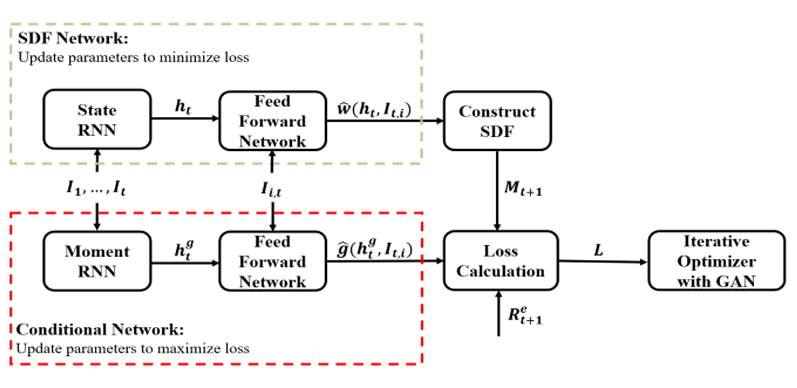Daily Asset Pricing Based on Deep Learning: Integrating No-Arbitrage Constraints and Market Dynamics
DOI:
https://doi.org/10.70393/6a6374616d.333235ARK:
https://n2t.net/ark:/40704/JCTAM.v2n6a01Disciplines:
Artificial Intelligence and IntelligenceSubjects:
Deep LearningReferences:
20Keywords:
No-arbitrage, Asset Pricing, Stock Returns, Deep Learning, LSTM, CNN, GAN, Market DynamicsAbstract
We propose a novel deep learning approach to asset pricing that predicts individual stock returns using daily data while integrating no-arbitrage constraints and capturing market dynamics. Our model combines Long Short-Term Memory (LSTM) networks, Convolutional Neural Networks (CNN), and Generative Adversarial Networks (GAN) to model the complex relationships between stock returns and various conditioning variables, including macroeconomic indicators, technical indicators, and market sentiment data. By incorporating the no-arbitrage condition into the deep learning framework, we enhance the accuracy and stability of asset pricing. We estimate a stochastic discount factor that explains asset returns from the conditional moment constraints implied by no-arbitrage. Our method outperforms traditional multi-factor models, such as the Fama-French model, in terms of Sharpe ratio, explained variation, and pricing errors. The GAN enforces the no-arbitrage constraint by identifying portfolio strategies that contain the most pricing information. The LSTM network uncovers hidden economic states, while the feedforward network captures the non-linear effects of conditioning variables. This research provides a new direction in asset pricing by applying deep learning to integrate market dynamics and enforce no-arbitrage constraints, offering more accurate pricing and valuable insights for generating profitable investment strategies.
References
[1] Liu, Z. (2022, January 20–22). Stock volatility prediction using LightGBM based algorithm. In 2022 International Conference on Big Data, Information and Computer Network (BDICN) (pp. 283–286). IEEE.
[2] Pang, F. (2020, November). Research on Incentive Mechanism of Teamwork Based on Unfairness Aversion Preference Model. In 2020 2nd International Conference on Economic Management and Model Engineering (ICEMME) (pp. 944-948). IEEE.
[3] Sun, Y., & Ortiz, J. (2024). An ai-based system utilizing iot-enabled ambient sensors and llms for complex activity tracking. arXiv preprint arXiv:2407.02606.
[4] Pang, F. (2025). Animal Spirit, Financial Shock and Business Cycle. European Journal of Business, Economics & Management, 1(2), 15-24.
[5] Sun, J., Zhang, S., Lian, J., Fu, L., Zhou, Z., Fan, Y., & Xu, K. (2024, December). Research on Deep Learning of Convolutional Neural Network for Action Recognition of Intelligent Terminals in the Big Data Environment and its Intelligent Software Application. In 2024 IEEE 7th International Conference on Automation, Electronics and Electrical Engineering (AUTEEE) (pp. 996-1004). IEEE.
[6] Tan, Z., Li, Z., Liu, T., Wang, H., Yun, H., Zeng, M., ... & Jiang, M. (2025). Aligning large language models with implicit preferences from user-generated content. arXiv preprint arXiv:2506.04463.
[7] Li, K., Liu, L., Chen, J., Yu, D., Zhou, X., Li, M., ... & Li, Z. (2024, November). Research on reinforcement learning based warehouse robot navigation algorithm in complex warehouse layout. In 2024 6th International Conference on Artificial Intelligence and Computer Applications (ICAICA) (pp. 296-301). IEEE. 11
[8] He, Y., Wang, J., Li, K., Wang, Y., Sun, L., Yin, J., ... & Wang, X. (2025). Enhancing Intent Understanding for Ambiguous Prompts through Human-Machine Co-Adaptation. arXiv preprint arXiv:2501.15167. 11
[9] Wang J, Cao S, Tim K T, et al. A novel life-cycle analysis framework to assess the performances of tall buildings considering the climate change[J]. Engineering Structures, 2025, 323: 119258.
[10] He, Y., Li, S., Li, K., Wang, J., Li, B., Shi, T., ... & Wang, X. (2025). Enhancing Low-Cost Video Editing with Lightweight Adaptors and Temporal-Aware Inversion. arXiv preprint arXiv:2501.04606. 1
[11] Li, X., Cao, H., Zhang, Z., Hu, J., Jin, Y., & Zhao, Z. (2024). Artistic Neural Style Transfer Algorithms with Activation Smoothing. arXiv preprint arXiv:2411.08014. 3
[12] Wu, H., Liu, J., Zha, Z. J., Chen, Z., & Sun, X. (2019, August). Mutually Reinforced Spatio-Temporal Convolutional Tube for Human Action Recognition. In IJCAI (pp. 968-974).
[13] Li, X., Wang, X., Qi, Z., Cao, H., Zhang, Z., & Xiang, A. DTSGAN: Learning Dynamic Textures via Spatiotemporal Generative Adversarial Network. Academic Journal of Computing & Information Science, 7(10), 31-40. 3
[14] Wang, H., Li, Q., & Liu, Y. (2022). Regularized Buckley–James method for right‐censored outcomes with block‐missing multimodal covariates. Stat, 11(1), e515.
[15] Wang, H., Li, Q., & Liu, Y. (2023). Adaptive supervised learning on data streams in reproducing kernel Hilbert spaces with data sparsity constraint. Stat, 12(1), e514.
[16] Wang, H., Sun, W., & Liu, Y. (2022). Prioritizing autism risk genes using personalized graphical models estimated from single-cell rna-seq data. Journal of the American Statistical Association, 117(537), 38-51.
[17] Wang, P., Wang, H., Li, Q., Shen, D., & Liu, Y. (2024). Joint and individual component regression. Journal of Computational and Graphical Statistics, 33(3), 763-773.
[18] Wu, H., Liu, J., Zhu, X., Wang, M., & Zha, Z. J. (2021, January). Multi-scale spatial-temporal integration convolutional tube for human action recognition. In Proceedings of the Twenty-Ninth International Conference on International Joint Conferences on Artificial Intelligence (pp. 753-759).
[19] Tao Y.SOBA: sequential query-based blackbox attack, Fifh International Conference onArtificial Intelligence and Computer Science (AICS 2023). SPIE, 2023, 12803: 721-729.
[20] Huang, T., Yi, J., Yu, P., & Xu, X. (2025). Unmasking digital falsehoods: A comparative analysis of llm-based misinformation detection strategies. arXiv preprint arXiv:2503.00724.

Downloads
Published
How to Cite
Issue
Section
ARK
License
Copyright (c) 2025 The author retains copyright and grants the journal the right of first publication.

This work is licensed under a Creative Commons Attribution 4.0 International License.


















